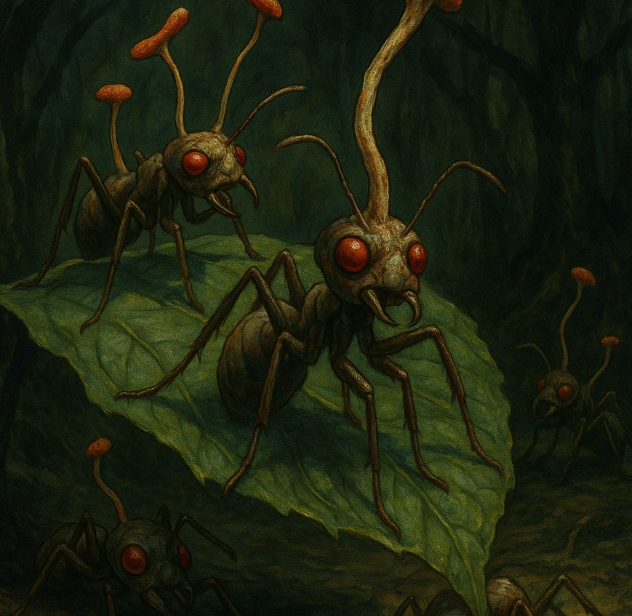
When the Forest Becomes a Graveyard of Zombie Ants
In the humid understory of a Thai rainforest, entire graveyards of ants cling to leaves in eerie silence. Their jaws are locked in a “death grip,” stalks of fungus bursting grotesquely from their heads. These aren’t ordinary corpses. They are the casualties of a parasite that doesn’t just kill—it controls minds first.
But here’s where it gets interesting: new science is revealing that this real-life horror story is less about brute destruction and more about precision manipulation.
The Everyday Made Horrific
If you’ve ever watched ants march in lines across your kitchen, you know how disciplined they are. Now imagine one suddenly veering away, staggering like it’s drunk, climbing a plant, and then—at exactly solar noon—biting into a leaf and waiting to die.
For the ant colony, this is a nightmare. For the fungus Ophiocordyceps, it’s a masterstroke of survival. The ant’s body becomes a platform for the fungus’s fruiting stalk, which rains down spores onto the forest floor, ready to infect the next victim.
The Research Story: Forest Graveyards and Fungal Puppeteers
In Southern Thailand, researchers surveyed 1,360 square meters of rainforest and mapped every single infected ant. They found 2243 corpses clustered into patches they called “graveyards,” some with up to 26 dead ants per square meter. Imagine stumbling upon a patch of forest where the ground is dotted with silent bodies, each frozen in a grotesque pose.
Even more chilling: the healthy host species, Camponotus leonardi, seemed to actively avoid these areas. Ant trails rarely touched the forest floor, and when they did, they quickly returned to the canopy. The living knew the risk. The dead made it visible.
Meanwhile, molecular biologists have been investigating how Ophiocordyceps works its magic. It doesn’t just rot the brain. Instead, it protects neural tissue while releasing a cocktail of toxins and secreted proteins that scramble behavior with surgical precision.
- Enterotoxins may hijack the ant’s sensory systems, interfering with smell and light perception.
- Aflatrem-like alkaloids induce the staggering, tremor-filled walk—what scientists call the “drunkard’s gait.”
- Protein tyrosine phosphatases may hack into the ant’s biological clock, ensuring that the death bite happens at exactly the right time of day.
- Small secreted proteins likely bind to insect receptors, tweaking dopamine and octopamine pathways that normally control foraging and social behavior.
This isn’t random infection—it’s a horror story written in molecular code.
Global and Historical Parallels
Behavior-manipulating parasites aren’t unique to ants. Hairworms drive crickets to drown themselves. Wasps force spiders to weave protective cocoons for larvae. Even viruses in caterpillars can induce “treetop disease,” making them climb and die high above the ground, just like zombie ants
Across cultures, humans have spun myths about mind control—vampires, witches, possession. The difference is, Ophiocordyceps isn’t legend. It’s happening, silently, right now in rainforests from Brazil to Thailand.
Why It Matters Beyond the Spook Factor
Yes, the image of zombie ants clamped to leaves is straight out of a horror film. But this research also carries practical weight.
- Pest control: By understanding fungal effectors—the proteins and toxins fungi use—we may one day design eco-friendly ways to manage crop pests without heavy chemical sprays.
- Disease ecology: Mapping ant graveyards shows how infections ripple through populations and environments, offering insights into how other pathogens—human or animal—spread in space and time.
- Evolutionary biology: Each Ophiocordyceps species has evolved to target a single ant host, a chilling reminder of how precise and narrow evolution can be when survival is at stake.
Tension and Resolution
We once thought parasites were simply destructive invaders. The truth is far darker: they are engineers of behavior, sculpting hosts like puppets. What looks like chaos—the staggering ant, the scattered graveyards—is actually an intricate strategy honed over millions of years.
But there’s a twist: while the fungus gains, the colony adapts. Ants shift trails to the canopy, avoiding danger. Even in horror, life finds countermeasures.
Closing: Let’s Explore Together
Next time you hear rustling in the forest, remember: somewhere nearby, an ant is climbing its final ladder under the command of a fungus.
- Could these fungal tricks inspire safer, more natural pest control in your country?
- If you were a scientist on this team, would you study the graveyards or the molecular toxins first?
- What other everyday behaviors—of insects, animals, even humans—might secretly be shaped by unseen parasites?
Science doesn’t just chase answers. Sometimes, it walks us straight into the shadows—and asks if we’re brave enough to look closer.



